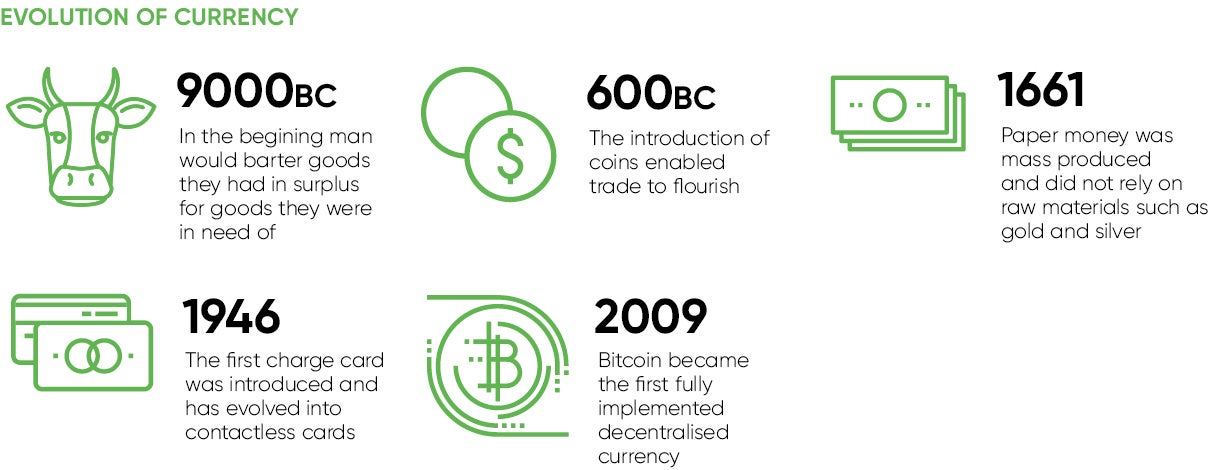Following a year of wild growth, digital currencies, which are independent of governments and banks, continue to gain credibility as retailers, nations and even traditional financial institutions race to embrace them.
2017 has proved to be the year of cryptocurrencies, with many reaching unprecedented values and confounding naysayers by smashing record after record. But why have these new digital currencies become so popular and can we expect this to continue?
While traditional currencies, such as sterling and the US dollar, are backed by governments or central banks, which can influence their value through fiscal intervention and monetary policies, cryptocurrencies are based on algorithms and mathematical proofs.
The underlying technology and infrastructure is blockchain, a decentralised digital ledger that records transactions on a peer-to-peer network, which is secured by a range of unrelated individuals, called miners, who must solve mathematical puzzles. This allows digital currency transactions to be recorded without central record-keeping.
Cryptocurrencies are sheltered from inflation. For example, since the number of bitcoins that can be created has a cap, the currency will not suffer from inflation in the way the pound would if the government prints too much cash.
Digital currencies only began to be traded in 2010, when a bitcoin could be snapped up for a few pence. Seven years on and, at the time of writing, it will set you back $10,000. In June, the International Monetary Fund issued a staff discussion note stating that banks should consider investing in cryptocurrencies.
“The story for cryptocurrencies has focused on whether they can become real-world currencies, capable of global transactions on a large scale,” says Iqbal Gandham, UK managing director at eToro, a global social trading and investment platform, which offers more than 1,200 instruments across stocks, commodities, foreign exchange, exchange-traded funds, indices and cryptocurrencies. “With bitcoin’s market cap continuing to grow and now sitting at over $160 billion, this is looking increasingly likely.”
eToro was founded more than ten years ago as a platform, which helps open up the markets to everyone. “We differ from traditional asset managers by giving investors more transparency over their investments, which they can view online at any time,” says Mr Gandham. “We also offer our six million registered users an online community to discuss trading strategies, which is now becoming heavily focused on cryptocurrency topics.”
For bitcoin to become a widely adopted currency that people spend on a daily basis, it will need to reach a price where daily fluctuations of £100 to £200 are insignificant compared to its price. Consumers won’t spend bitcoins in the future but denominations of it, such as the satoshi, which is a 100-millionth of a bitcoin.
The tremendous success of cryptocurrencies is reflected in the fact that, at the time of writing, 15 have a market size of more than $1 billion and big brands, including Expedia and Subway, accept bitcoin as payment. But given the market’s youth, there is still volatility, which has seen prices swings in reaction to events, such as organisations supporting a cryptocurrency, announcements of “hard forks”, where a cryptocurrency splits into two, or news relating to the introduction of bitcoin futures, allowing users to fix a set price they’d like to buy or sell at a fixed time.
The volatility that we’ve seen this year presents an exciting opportunity for traders and has shown positive growth for long-term investors
“Investors can capitalise on these swings,” says Mr Gandham. eToro allows clients to buy the underlying crypto asset or short, via a contract for difference, to take advantage of price falls. “We recommend a diversified approach to shelter from cryptocurrency volatility, as with any investment there is a risk you will not get back the capital you put in. However, the volatility that we’ve seen this year presents an exciting opportunity for traders and has shown positive growth for long-term investors.”
While bitcoin is often the go-to crypto investment as it’s the best-known, there are in fact more than 1,000 cryptocurrencies to choose from, including ethereum, litecoin, dash and XRP. Traders and investors should understand the underlying business case for each prior to investing.
Those confident and knowledgeable can buy and short the top seven cryptocurrencies manually through eToro. But as this can be daunting for less-advanced investors, users can also automatically copy the trading strategies of eToro’s top performing cryptocurrency experts, such as Wes Nolte, Alex Plesk and Jay Smith, who has returned over 300 per cent in the last 12 months and is now copied by more than $16 million on the platform.
Furthermore, for those who believe in the technology’s potential, eToro’s Crypto CopyFund allows you to invest in the world’s biggest cryptocurrencies – bitcoin, ethereum, ethereum classic, XRP, litecoin and dash – in one innovative portfolio, which has seen more than 70 per cent returns in the last six months.
As platforms such as eToro open up the market for anyone to invest in cryptocurrencies in a straightforward and transparent way, the future is bright for this medium of exchange. “We will continue to find ways to make trading and investing in cryptocurrencies, as well as other instruments, accessible for everyone,” Mr Gandham concludes.
For more information please visit www.eToro.com





